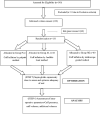Comparative evaluation of three methods of endotracheal tube cuff inflation for adequacy of seal
- PMID: 36778817
- PMCID: PMC9912873
- DOI: 10.4103/joacp.JOACP_560_20
Comparative evaluation of three methods of endotracheal tube cuff inflation for adequacy of seal
Abstract
Background and aims: Intubation with cuffed endotracheal tube (ETT) is common in operation rooms, critical care, and emergency rooms. The pressure exerted by the cuff on the tracheal mucosa can lead to a reduction in blood flow to the tracheal wall and result in mucosal ischemia. There are many methods for ETT cuff inflation. Aim of the study was to compare the cuff pressures and volumes between the three methods of ETT cuff inflation.
Material and methods: One hundred and twenty patients were randomized into three groups: Group SG (stethescope guided), group AL (audible leak), and group P (palpation). In group SG, the cuff was inflated by auscultating with the bell of the stethoscope over the thyroid cartilage for leak around cuff. In group AL, the cuff was inflated by listening for an audible leak around the cuff with observer's ear 5 cm away from the mouth of the patient. In group P, the cuff was inflated by palpating for a leak over the cricoid and trachea. The adequacy of the cuff seal was compared between the groups by assessing the volumes of additional air needed to stop the leak around the cuff as confirmed by supraglottic capnometry.
Results: The initial volumes needed to inflate the cuff were significantly more in the stethoscope (SG) and hearing (AL) groups than in the palpation (P) group (SG = 5.1 ± 1.4 ml, AL = 4.6 ± 1.6 ml, P = 3.1 ± 0.9 ml; SG and AL vs. P, P < 0.001). Additional cuff volumes required to achieve zero leak around cuff by supraglottic capnometry were 0.85 ± 1 ml in group SG, 1.3 ± 1.1 ml in group AL, and 2.237 ± 0.8 ml in group P (SG vs. P and AL vs. P; P < 0.001).
Conclusion: Out of the auscultation-guided, audible leak-guided, and palpation-guided methods of ETT cuff inflation, the auscultation-guided and audible leak-guided methods achieve significantly better tracheal seal than the palpation-guided method.
Keywords: Cuff inflation; EtCO2; endotracheal tube.
Copyright: © 2022 Journal of Anaesthesiology Clinical Pharmacology.
Conflict of interest statement
There are no conflicts of interest.
Figures
Similar articles
-
Evaluation of audible leak versus pressure volume loop closure for polyvinyl chloride cuff and polyurethane microcuff in endotracheal tube inflated with air: a prospective randomized study.Med Gas Res. 2021 Jan-Mar;11(1):6-11. doi: 10.4103/2045-9912.310053. Med Gas Res. 2021. PMID: 33642331 Free PMC article. Clinical Trial.
-
Endotracheal Tube Cuff Inflation Methods in School-Age Children: Flow-Volume Loop-Guided Versus Stethoscope-Guided.Respir Care. 2025 Feb;70(2):176-183. doi: 10.1089/respcare.12076. Respir Care. 2025. PMID: 39964846 Clinical Trial.
-
Clinical evaluation of stethoscope-guided inflation of tracheal tube cuffs.Anaesthesia. 2011 Nov;66(11):1012-6. doi: 10.1111/j.1365-2044.2011.06853.x. Epub 2011 Aug 18. Anaesthesia. 2011. PMID: 21851343 Clinical Trial.
-
Comparison between Two Endotracheal Tube Cuff Inflation Methods; Just-Seal Vs. Stethoscope-Guided.J Clin Diagn Res. 2017 Jun;11(6):UC01-UC03. doi: 10.7860/JCDR/2017/26301.10017. Epub 2017 Jun 1. J Clin Diagn Res. 2017. PMID: 28764268 Free PMC article.
-
Endotracheal tubes: old and new.Respir Care. 2014 Jun;59(6):933-52; discussion 952-5. doi: 10.4187/respcare.02868. Respir Care. 2014. PMID: 24891200 Review.
Cited by
-
Risk factor evaluation of cuff pressure of >30 cmH2O to stop air leakage during mechanical ventilation: A prospective observational study.Nurs Open. 2024 Jun;11(6):e2187. doi: 10.1002/nop2.2187. Nurs Open. 2024. PMID: 38837558 Free PMC article.
-
Relationship between difference in endotracheal tube cuff area and airway area with minimum cuff pressure for adequate airway sealing: a prospective observational study.Sci Rep. 2025 Feb 18;15(1):5875. doi: 10.1038/s41598-025-85355-x. Sci Rep. 2025. PMID: 39966434 Free PMC article.
References
-
- Liu J, Zhang X, Gong W, Li S, Wang F, Fu S, et al. Correlations between controlled endotracheal tube cuff pressure and postprocedural complications: A multicenter study. Anesth Analg. 2010;111:1133–7. - PubMed
-
- Ahmed A, Abbasi S, Ghafoor HB, Ishaq M. Postoperative sore throat after elective surgical procedures. J Ayub Med Coll Abbottabad. 2007;19:12–4. - PubMed
LinkOut - more resources
Full Text Sources
Medical


